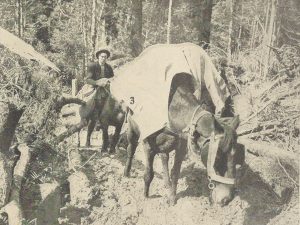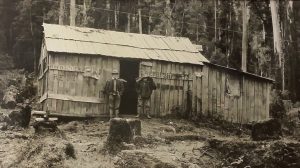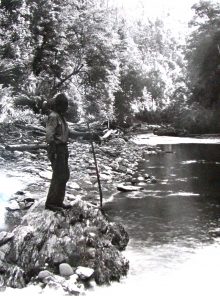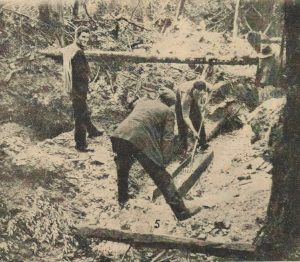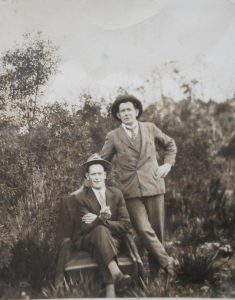
He was Irish, he was a dyed-in-the-wool member of the Labor Party, and he was a socialist. Those are things we can say with certainty about the ‘voice of Adamsfield’, ‘Mulga Mick’ O’Reilly. Beyond that, a lot of his life is open to debate. This well-travelled digger wrote two books, The Pinnacle Road and other verses (1935), which was a collection of his poems, most of them from his Tasmanian days, and the autobiography Bowyangs and boomerangs: reminiscences of 40 years’ prospecting in Australia and Tasmania (1944).
How reliable were they? Mick’s son John O’Reilly recalled his aunts saying that Bowyangs and boomerangs was mostly fabrication. In it he claimed tragic beginnings. Having been born at Shinrone, County Offaly, Ireland, in 1879, he lost his first wife and two sons in an influenza epidemic before coming to Australia. [1]
One of the things that makes it hard to keep track of ‘Mulga Mick’ is his way of acquiring other people’s memories. He loved to compose stirring poetry. He wrote as if he was the spirit of mineral prospecting, speaking for all the diggers. One of his efforts, ‘The men of ‘93’, was written about times on the Western Australian goldfields he probably never experienced. Perhaps he recorded the stories of old diggers, and then, like a true dramatist, he gave these immediacy by writing them up in the first person.
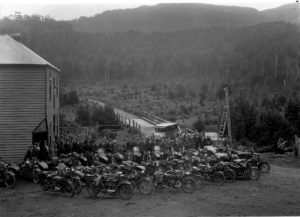
In 1933 he wrote a lament for the Whyte River Hotel, which was the watering hole for the Nineteen Mile osmiridium field west of Waratah. The pub burnt down in 1929—and O’Reilly probably never laid eyes on it. Yet he described it with the utmost intimacy. Reading his poem, you would swear he had tied one with Jim McGinty, Tom Rouse, Sammy Dwyer and all the other veterans of the field. Even ‘old Burly Lynch’ the publican, lining the drinks up on the bar, got a run. Yet Lynch surrendered the licence of the Whyte River Hotel in 1912, many years before O’Reilly arrived in Tasmania.[2]
Likewise, ‘The Adams River Rush’ described an event he hadn’t attended.[3] The rush occurred in the spring of 1925. He was certainly at Adamsfield in 1928, and through the Great Depression years, the toughest times on that osmiridium field. During these years he delivered missives from the diggings that captured many facets of the experience—the longing for loved ones and the comforts of town; the misery of stirring from a warm bed to work in the mud; comic arguments and drunken fist fights; and the general scrap to make money and hang on to it.
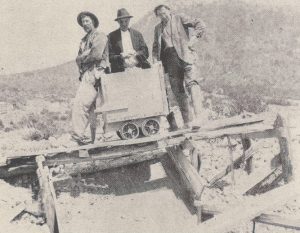
Life was very simple for O’Reilly. The world was divided into ‘haves’ and ‘have nots’, that is, the parasite (the master) and the exploited (the servant). O’Reilly spelt ‘Digger’ with a capital ‘D’, whether that be the diggers of Adamsfield or the diggers of Gallipoli, because to him they were of the same manly ilk. All politicians were parasites who took the food from children’s mouths.[4] Miners’ wives and Adamsfield bush nurses were angels.[5] The press was also parasitic and should be ‘cleared from the face of all lands’, except, presumably, when newspapers bore his own copious contributions.[6] His penmanship was fluent, eloquent and often sympathetic to the down-trodden and forgotten, like the ‘heroes’ of Gallipoli, the elderly, the poor.[7] O’Reilly saw the Adamsfield osmiridium field as the epitome of the worker’s struggle for survival with dignity. He urged the workers to strike a blow for freedom against ‘pampered parasites [stealing] our children’s bread’, citing a particularly pathetic example of a large, young family forced to trudge out to the remote diggings.[8] ‘Out latest hospital: is not finished yet’, published in Hobart newspaper the Voice in 1931, was a protest about poor public infrastructure. Adamsfield was in the ridiculous situation of having a hospital with no bathroom, patients having to bathe in a passing water race:
‘When the smoke goes curling through the hole
Where the chimney ought to be,
And the old black billy on the fire
To make the evening tea;
When the hurricane lamp is lighted up,
Then you can safely bet,
It looks more like a Digger’s Camp
That is not finished yet.
If a patient ever gets a bath,
It’s on the instalment plan,
With just a little drop each day
From out the billy-can.
He rubs himself both her and there
Till he is partly wet:
Some day he may get over all,
For the bathroom’s not finished yet.’[9]
There was plenty of humour in his verse. When Jack Brennan claimed to have found a lode of osmiridium, O’Reilly predicted that it would only bring him enough money to buy a new commode.[10] In ‘The lady dentist’s visit to Adamsfield’ he described the anticipation of some rare female attention when Hobart dentist Olive Shepherd decided to make a business call to the diggings:
‘Some developed toothache that had never had a tooth
Since their father’s hairy lug they used to bite,
Another one’s got gumboils all around the ancient root
Of the one and only molar that’s in sight …
Not for years can we remember when excitement ran so high,
Or a ‘shepherd’ caused such stir among the sheep.
Now the old and toilworn Diggers wear a collar and a tie,
It’s enough to make the blooming angels weep.’[11]
However, O’Reilly’s pet plan to increase digger prosperity and extend the life of the osmiridium field was deadly serious. He wanted the government to fund a scheme to drain about 1000 acres of swampy flats along the Adams River which he claimed he had already tested successfully for metal. Without producing a single assay report as evidence, he claimed this would return about £200,000-worth of osmiridium.[12] The idea was to drain the area by way of a deep tail race terminating at the Adams River Falls, although others hit upon a more radical plan to blast away the falls themselves, thereby increasing the river flow. Asked to report on the scheme in 1931, Government Geologist PB Nye claimed that the area which would benefit from drainage was at most 667 acres and that insufficient work had been done to prove that the ground in question contained payable osmiridium—let alone osmiridium that would justify an outlay of anything up to £10,000 on such a tail race.[13]
O’Reilly retired to Glenorchy, took a job as a labourer building the Pinnacle Road up Mount Wellington, above Hobart, and continued to fire off instructions for a better world. St Peter probably copped an earful as ‘Mulga Mick’ stormed the Pearly Gates.
[1] MJ O’Reilly (‘Mulga Mick’), Bowyangs and boomerangs: reminiscences of 40 years’ prospecting in Australia and Tasmania, Hesperian, Carlisle, WA, 1984 reprint, p.160; John O’Reilly, ‘Mulga Mick; prospector, miner, author and poet: a lost father rediscovered’, Tasmanian Ancestry, December 2013, p.149.
[2] The old Whyte River Pub’, Advocate, 16 September 1933, p.8; reprinted in MJ O’Reilly, ‘Mulga Mick’, The Pinnacle Road and other verses, the author, Hobart, 1935, pp.62‒64. The Whyte River Hotel was never rebuilt.
[3] MJ O’Reilly, ‘Mulga Mick’, ‘The Adams River Rush’, The Pinnacle Road and other verses, pp.55–57.
[4] See, for example, ‘Mulga Mick’ (MJ O’Reilly), ‘Stealing the children’s bread: lesson of the Adamsfield Track’, Voice, 30 April 1932, p.7.
[5] For diggers’ wives and bush nurses as angels, see MJ O’Reilly, ‘Mulga Mick’, ‘The ossie diggers’ wives at Adamsfield’, in The Pinnacle Road and other verses, the author, Hobart, 1935, pp.28‒29; and ‘Sister’s sympathy’, Voice, 11 April 1931, p.6.
[6] For the ‘parasitic press’, see ‘Mulga Mick’ (MJ O’Reilly), ‘A poetic exchange’, Voice, 16 May 1931, p.2.
[7] See ‘Mulga Mick’ (MJ O’Reilly), ‘Armistice Day: “We’ll ne’er forget the price”’, Voice, 7 November 1931, p.1; and ‘Stealing the children’s bread: lesson of the Adamsfield Track’, Voice, 30 April 1932, p.7.
[8] ‘Mulga Mick’ (MJ O’Reilly), ‘Stealing the children’s bread: lesson of the Adamsfield Track’, Voice, 30 April 1932, p.7.
[9] ‘Mulga Mick’ (MJ O’Reilly), ‘Not finished yet’; quoted in ‘Our latest hospital’, Voice, 3 January 1931, p.2.
[10] ‘Jack Brennan’s osie [sic] lode’, poem signed ‘Mulga Mick’, dated 1929, and reprinted in CA Bacon, Notes on the mining and history of Adamsfield, Report, no.1992/20, Mineral Resources Tasmania, Hobart, 1992, p.8.
[11] MJ O’Reilly, ‘Mulga Mick’, ‘The lady dentist’s visit to Adamsfield’, The Pinnacle Road and other verses, pp.47–48.
[12] ‘Mulga Mick’ (MJ O’Reilly), ‘Osmiridium diggers’, Mercury, 2 September 1932, p.8; MJ O’Reilly, ‘Adamsfield development’, Mercury, 7 February 1933, p.6.
[13] PB Nye, ‘Proposal to drain the Adams River Flats by constructing a deep tail race at the Adams River Falls’, Unpublished Report, 76–79/1931, Department of Mines, Hobart, p.78; ‘Osmiridium’, Mercury, 16 January 1933, p.5.
